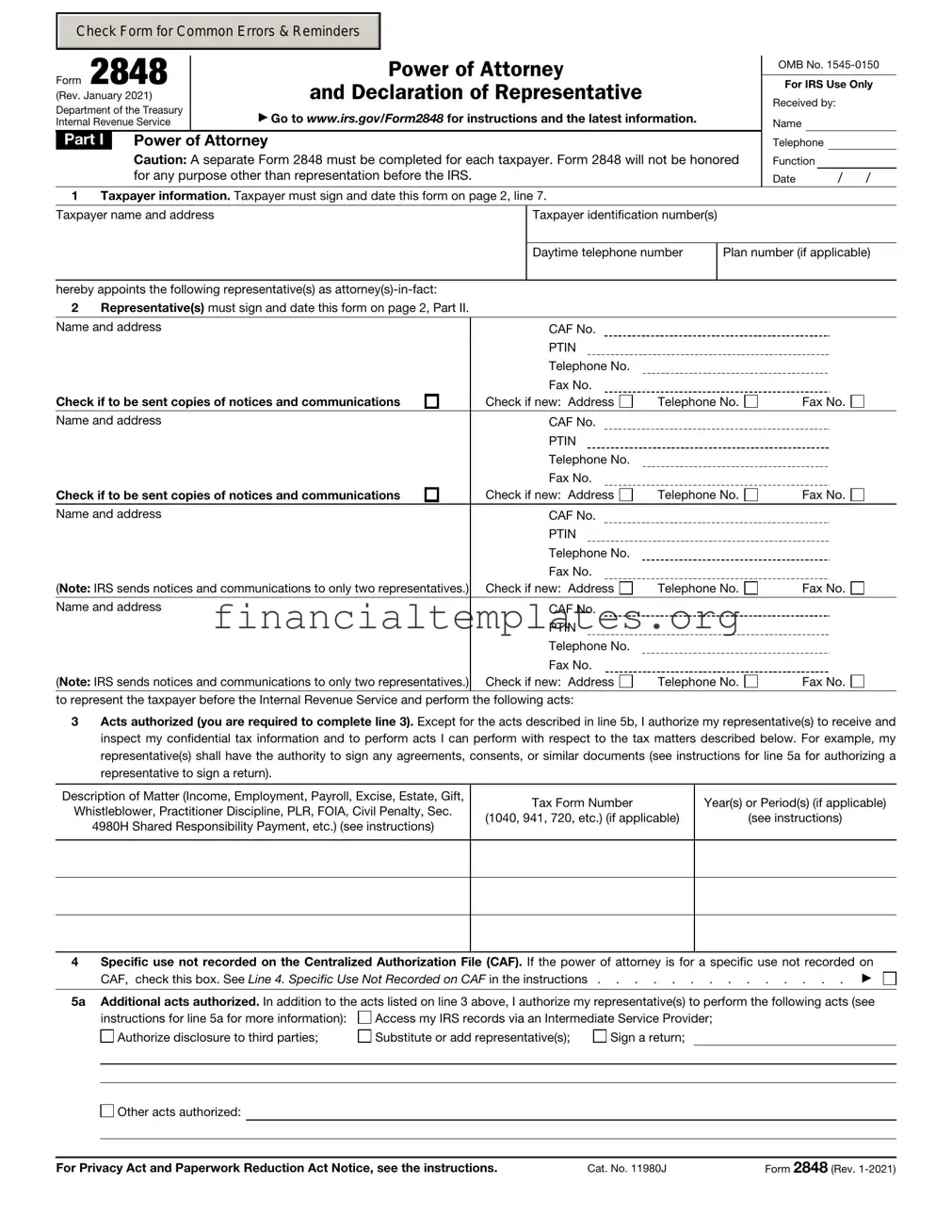Form 2848 (Rev. 1-2021) |
Page 2 |
bSpecific acts not authorized. My representative(s) is (are) not authorized to endorse or otherwise negotiate any check (including directing or accepting payment by any means, electronic or otherwise, into an account owned or controlled by the representative(s) or any firm or other entity with whom the representative(s) is (are) associated) issued by the government in respect of a federal tax liability.
List any other specific deletions to the acts otherwise authorized in this power of attorney (see instructions for line 5b):
6Retention/revocation of prior power(s) of attorney. The filing of this power of attorney automatically revokes all earlier power(s) of attorney on file with the Internal Revenue Service for the same matters and years or periods covered by this form. If you do not want to
revoke a prior power of attorney, check here . . . . . . . . . . . . . . . . . . . . . . . . . . . ▶
YOU MUST ATTACH A COPY OF ANY POWER OF ATTORNEY YOU WANT TO REMAIN IN EFFECT.
7Taxpayer declaration and signature. If a tax matter concerns a year in which a joint return was filed, each spouse must file a separate power of attorney even if they are appointing the same representative(s). If signed by a corporate officer, partner, guardian, tax matters partner, partnership representative (or designated individual, if applicable), executor, receiver, administrator, trustee, or individual other than the taxpayer, I certify I have the legal authority to execute this form on behalf of the taxpayer.
▶ IF NOT COMPLETED, SIGNED, AND DATED, THE IRS WILL RETURN THIS POWER OF ATTORNEY TO THE TAXPAYER.
Signature |
Date |
Title (if applicable) |
Print name |
|
Print name of taxpayer from line 1 if other than individual |
Part II Declaration of Representative
Under penalties of perjury, by my signature below I declare that:
•I am not currently suspended or disbarred from practice, or ineligible for practice, before the Internal Revenue Service;
•I am subject to regulations in Circular 230 (31 CFR, Subtitle A, Part 10), as amended, governing practice before the Internal Revenue Service;
•I am authorized to represent the taxpayer identified in Part I for the matter(s) specified there; and
•I am one of the following:
aAttorney—a member in good standing of the bar of the highest court of the jurisdiction shown below.
bCertified Public Accountant—a holder of an active license to practice as a certified public accountant in the jurisdiction shown below.
cEnrolled Agent—enrolled as an agent by the IRS per the requirements of Circular 230.
dOfficer—a bona fide officer of the taxpayer organization.
eFull-Time Employee—a full-time employee of the taxpayer.
fFamily Member—a member of the taxpayer’s immediate family (spouse, parent, child, grandparent, grandchild, step-parent, step-child, brother, or sister).
gEnrolled Actuary—enrolled as an actuary by the Joint Board for the Enrollment of Actuaries under 29 U.S.C. 1242 (the authority to practice before the IRS is limited by section 10.3(d) of Circular 230).
hUnenrolled Return Preparer—Authority to practice before the IRS is limited. An unenrolled return preparer may represent, provided the preparer (1) prepared and signed the return or claim for refund (or prepared if there is no signature space on the form); (2) was eligible to sign the return or claim for refund; (3) has a valid PTIN; and (4) possesses the required Annual Filing Season Program Record of Completion(s). See Special Rules and Requirements for Unenrolled Return Preparers in the instructions for additional information.
kQualifying Student or Law Graduate—receives permission to represent taxpayers before the IRS by virtue of his/her status as a law, business, or accounting student, or law graduate working in a LITC or STCP. See instructions for Part II for additional information and requirements.
rEnrolled Retirement Plan Agent—enrolled as a retirement plan agent under the requirements of Circular 230 (the authority to practice before the Internal Revenue Service is limited by section 10.3(e)).
▶IF THIS DECLARATION OF REPRESENTATIVE IS NOT COMPLETED, SIGNED, AND DATED, THE IRS WILL RETURN THE POWER OF ATTORNEY. REPRESENTATIVES MUST SIGN IN THE ORDER LISTED IN PART I, LINE 2.
Note: For designations d–f, enter your title, position, or relationship to the taxpayer in the “Licensing jurisdiction” column.


